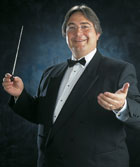Expert workshop - Section 1 - Voyage of Discovery
17-Feb-2006Dr. Robert Childs looks at the difficulties and problems that need to be overcome with the tricky First Section set work by Goff Richards.
 From the beginning to C needs to be exciting. To achieve this the tempo needs to be bright and the dynamics really observed. This movement is full of effects i.e. perc crescendo into 13, cnt gliss the 4th beat of 15, trb ffz bar 17, sub mp at 18 etc ect.
From the beginning to C needs to be exciting. To achieve this the tempo needs to be bright and the dynamics really observed. This movement is full of effects i.e. perc crescendo into 13, cnt gliss the 4th beat of 15, trb ffz bar 17, sub mp at 18 etc ect.
The excitement subsides a little at C and the tune at D needs to be played in a cantabile style. Be careful that the triangle and the back row are together. Between D and E there are several swells in the music but make sure the ff in bar 53 is the biggest.
Make sure you can hear the bass line at E and the euph and bass at F. Bar 72 is the loudest and brings the first section to a close.
The Andante to G is a bridge passage and needs careful rehearsing. G through to 108 is easy enough once the players grasp the concept of 16th time signatures. 108 to J needs to be free and not in tempo. Experiment with rubato but don't dwell on the sop's top C!!
J to K is where you can make a lot of music. Shape the phrases and balance the solos this section of the piece will catch the adjudicators ear, for sure.
K needs at least one trombone sectional. Don't let them over-blow. I think the neatest trombone section will be rewarded to most. The key word for me between K and bar 166 is ‘giocoso' keep the music light and full of fun. Blowing loud and fast will not achieve this.
At N the balance in the basses is crucial and the section that can achieve the sub mp in bar 196 will also be rewarded.
O to Q, again its very easy to over-blow this section. Make sure the over-riding feeling is one of majesty and not aggression, keep the band well balanced and in-tune.
Q needs to be light and nimble and the hardest bit of the section is at letter R. To achieve maximum effect here you'll probably be better off cutting down the number of players (don't forget the little swell in bar 245.
S is the beginning of the end and what an ending it is!
After 9 or 10 minutes of good playing you can throw the contest away with blasting from here to the end. Resist the temptation, keep all the sounds well balanced and in tune. Don't draw the ending out beyond the band's capability and don't let the percussion dominate.
Dr. Robert Childs















